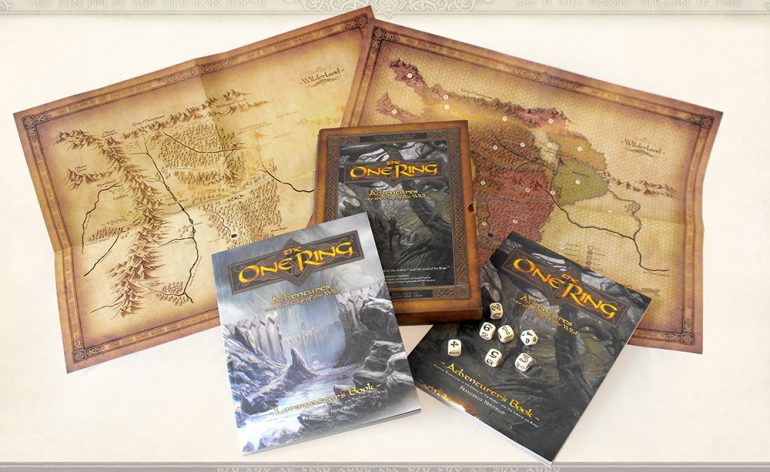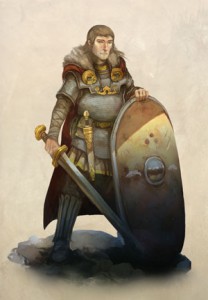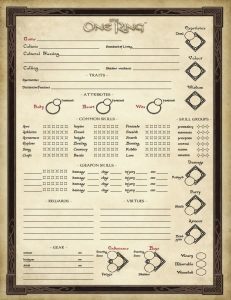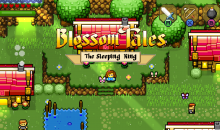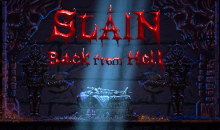The One Ring: Adventures Over the Edge of the Wild Review
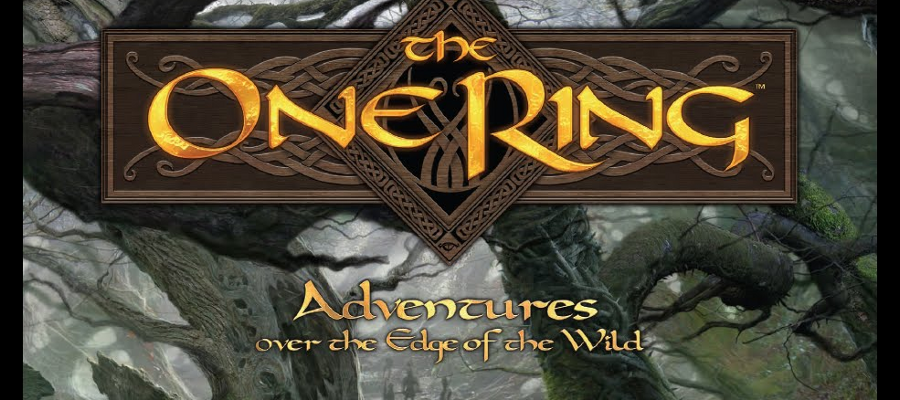
It is a tricky thing, capturing existing stories in roleplaying games. As Reuben said, all of Western fantasy has its roots inextricably tangled up in J.R.R. Tolkien’s world of Middle-earth. Yet most role playing products, a hobby birthed from the womb of Western fantasy, that attempt to capture the magic of Middle-earth fail. Despite the noble attempts by Iron Crown Enterprises’ Middle-earth Role Playing and Decipher’s The Lord of the Rings Roleplaying Game, there has yet to be a published product that does the original epics justice.
This brings us to Cubicle 7’s The One Ring: Adventures Over the Edge of the Wild. Having won many rewards in its year-long existence, it seems that The One Ring has been a success. Does The One Ring truly succeed where the others have failed?
Disclaimer: This is a review written after only reading the books, I have not seen the game in action.
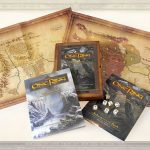 A Beautiful Game
A Beautiful Game
The One Ring is a box set that contains a rule book and map for the players and a rule book and map for the game master. (Called the “Loremaster”.) The books are beautiful, filled with gorgeous paintings of Middle Earth and verbiage inspired by Tolkien’s works. Include a set of custom dice, and you have a product that will please from the moment it’s opened.
A Tolkien-esque Game
The One Ring is designed with a laser focus: PCs are adventurers in the Wilderlands of Middle-earth set in the years between The Hobbit and The Lord of the Rings. Everything the players will experience is squarely set within the geological and narrative space of The Hobbit. PCs will cut across country, run into dangerous beasts, foil foul sorcery, and attempt to win over the hearts of the weary Free Peoples of Middle Earth. Amazing, right?
The system’s weight is supported by a single die pool mechanic:
- Roll a special 1d12 plus an additional 1d6 for each rank in an applicable skill. The 11 on the d12 has been replaced with an Eye of Sauron that counts as a zero, the 12 on the die has been replaced with the Elven rune of Gandalf which counts as an automatic success.
- Add all of the dice together and try to meet or exceed a target number.
- Some mechanics care about a degree of success, such as making a called shot in combat. The more 6’s rolled on the d6s the “better” the success.
There are many ways to boost your chances of success, but adding up a special d12 plus a number of d6s is all you really need to know. The game is a rules light “OSR” feeling fantasy game, more concerned with the story than moving a number of squares in tactical combat.
The One Ring uses a number of mechanics to invoke a Tolkien-esque sense of storytelling. For example, your PC’s Hope is a spiritual reserve that is slow to replenish but crucial to make a PC succeed. You can spend your PC’s Hope points during play to give them substantial boosts to their die rolls and to invoke special combat abilities.
Most players are familiar with “benny” systems such as this, but Hope is coupled with Shadow. PCs gain Shadow points as they are exposed to and do evil acts. While they are harmless on their own, if a PC’s current Hope reserve equals or falls below their Shadow point total they become Miserable. Rolling the Eye on the special d12 while Miserable causes your character to have a bout of madness and gain a permanent tick. The Hope/Shadow cycle is a simple mechanic that simulates the gradual fall from grace and redemption that is so crucial to Tolkien’s stories. (Think Boromir’s betrayal in the Fellowship of the Rings.)
Another crucial addition is the clever rule set for cross country journeys. The two maps in the box both detail the same Wilderland, but the Loremaster’s map has hexes to measure distance as well as color codes to represent the dangers and terrain. The players plot a course on their map and the Loremaster does some quick calculations to find the appropriate number of skill tests to make it safely to the destination. While the adventures that will be had are still plotted out by the Loremaster ahead of time (it’s not plot-agnostic like Mouse Guard is) it’s an exciting way to concretely represent the journeys so central to Tolkien’s stories.
I won’t continue to gush, but there are a few more worth mentioning: character creation rules that build flavor as well as they build characters, fully fleshed out rules for what players do in their down time, character-specific “magical loot” created from acts of Valor, and a Wisdom stat that represents character maturity and resilience to corruption.
The rules pass the test that previous Middle-earth roleplaying games couldn’t: The One Ring could organically weave most of the plots that you’d find in The Hobbit.
A Conflicted Game
Unfortunately, The One Ring is a game of split minds. It is clear that Cubicle 7 loves games like Mouse Guard and FATE, but the mechanics inspired by those games are underdeveloped. The prime example are the Traits that characters have (like Keen Eyed or Bold) that allow players to enjoy an automatic success in any test that the trait could assist in. Immediately, as the Loremaster, I wonder how I would stop Traits from circumventing moments where the results of a die roll could be a tense, fun moment at the table? The Trait system feels like a pet project that was one revision from being cut from the book.
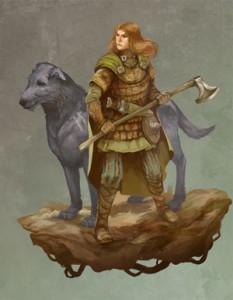 The One Ring’s combat system follows Tolkien’s habit of glossing over anything that might be exciting. The rules are abstract enough to be quick and easy, which is by design, but interesting choices are few and far between. Getting into martial spats in the Wild is a guarantee and many conflicts in the books are resolved with ringing steel; there needs to be rules to keep it interesting for the players. Those rule are not present here.
The One Ring’s combat system follows Tolkien’s habit of glossing over anything that might be exciting. The rules are abstract enough to be quick and easy, which is by design, but interesting choices are few and far between. Getting into martial spats in the Wild is a guarantee and many conflicts in the books are resolved with ringing steel; there needs to be rules to keep it interesting for the players. Those rule are not present here.
And finally, Encounters are The One Ring’s attempt at social combat. There are too few rules present to call it a subsystem. It amounts to a set of guidelines for using the various social skills paired with a Tolerance that measures the number of failed skill checks before the conversation goes irreparably south. Tolkien’s books are rife with social combat! Courtesy is wielded as a weapon, songs stir the hearts of men, characters regularly try to out-awe each other with their Many Names in Many Languages. For such an important part of Tolkien’s stories, the Encounter felt woefully underdeveloped and was my biggest disappointment.
What is The One Ring?
It isn’t an indie/story game. While the One Ring is peppered with tidbits from “indie” titles such as Mouse Guard, those tidbits are half-finished or poorly thought out.
It isn’t a crunchy fantasy heart breaker. Those looking for rules for exploring the ruins of lost civilizations, discovering magical swords in troll caves, and tactical combat against the Mirkwood’s spiders will be disappointed. While the mechanics are thematic, they are simple.
However, after all of that negativity, The One Ring is a rules light game that captures the magic of Tolkien’s universe. This game is going to scratch an itch for a very particular subset of gamers: those that want to recreate Tolkien’s high fantasy but are willing to overlook less-than-polished mechanics. If your group is one of the many over the years that is looking for a game that allows them to remain hopeful against corruption, show valor in an age of paranoia, wander to and fro, and fight poisonous spiders, then this game delivers like no other. It’s not for me, but it could very well be for you; calling down Tolkien’s original lightning bolt should not be dismissed. Give it a look.

